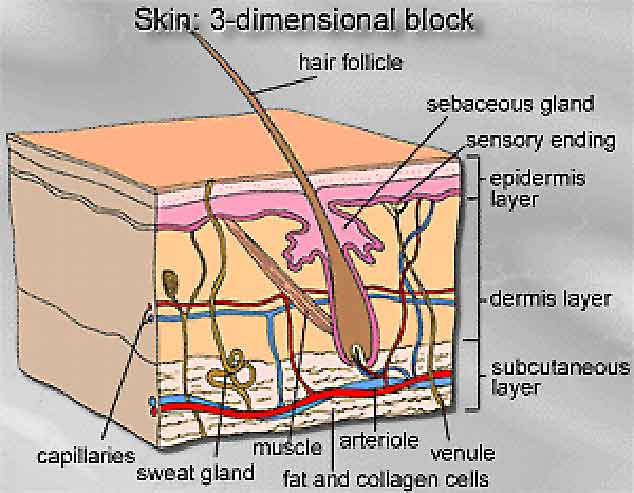Topic 5 - Dose Units
Beta Radiation |
 |
 |
Beta-ray interactions
- Use “beta-particle absorption curve” relationship given in Cember
with caution
Beta Radiation
- Beta radiation can be approximated by semilog behavior (see Fig 5.2).
- Intensity of radiation can be described by:

- j is the beta intensity at depth t
(energy/area/time)
- jo is the initial intensity
- mb is the beta-ray absorption
coefficient
Calculating mb
- If maximum beta-ray energy Em is in MeV, then mb
for air and tissue is given by:


Beta-Dose from Surface Contamination

- Ca, Bq cm2
- 50% betas up
- 50% betas down
- Energy flux at surface is

- j, fluence rate, energy area-1 time
- Ē, average energy per dis
- Surface dose-rate:

- Calculating in SI units:

- where k is a constant of unit conversions
- See Cember, p 188
Beta Skin Dosimetry
- Dead layer of skin provides some shielding
- After going through the dead layer of skin
- All the beta energy is generally deposited in the living tissue
- Betas generally only travel about 1 cm or less in tissue
- Energy deposited in tissue = dose
Anatomy of skin

Beta Skin Dosimetry
- Shielding provided by the dead layer of skin can be approximated
by (Equation 6.20):

- Energy absorbed by living tissue
- 0.007 g cm2
- Equation 6.26:

Beta Surface Dose
- If the beta emitter is not in contact with the skin, add in other
attenuating material, such as air, using appropriate coefficients
- Equation 6.20 gives attenuation in air
- Other attenuation by clothing
Standard Thickness
| Material |
Thickness(mm) |
Density(g/cm3) |
| Lab Coat (Plastic) |
0.1 |
0.036 |
| Cotton Glove Liner |
0.3 |
0.3 |
| Surgeon's Glove |
0.5 |
0.9 |
| Outer Glove (thick) |
0.45 |
1.1 |
| Ribbed Outer Glove |
0.55 |
0.9 |
| Plastic Bootie |
0.2 |
0.6 |
| Rubber Shoe Cover |
1.2 |
1.0 |
Submersion Dose
- Inside an infinite cloud of a radionuclide
- rate of energy emission = rate of energy absorption
- Given
- C Bq m3
- Ē beta energy (MeV)
- The dose rate is:

Submersion in 85Kr
- Assume the person is in an infinite cloud
- Rate of energy emission = rate of energy absorption
- Assume half the betas are emitted towards the skin, half away
- Assume tissue absorbs 10% more energy than tissue on a per kg basis
- Equation 6.40 is useful, but it is not necessary to memorize
Convert to Useful Units
- 1 ´ 10-6 microCi/cm3

= 3.7 ´ 104 Bq/m3
Calculating Submersion Dose
- 1.1 = 10% greater energy absorption
- 0.5 = Half up, half down
- e-0.007 ´ m = dead skin shielding
- Dose rate in seconds is found (UNITS!)

Submersion
- Combine terms


= 4.9 ´ 10-10 Gy/s = 1.7 ´ 10-6 Gy/hr
= 0.17 mrad/hr
Volume Source
- Useful for finding beta dose rates from container surfaces
- Assume infinite thickness
- Calculate dose rate in infinite medium
- Divide in half to find dose rate at surface
- Half go in, half go out
- Add in any shielding
|















